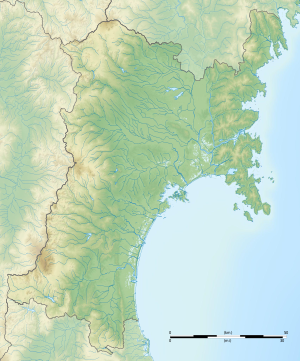Taga Castle
| Taga Castle | ||
|---|---|---|
|
In Taga Castle |
||
| Alternative name (s): | Taga no ki | |
| Creation time : | 724 | |
| Place: | Tagajō | |
| Geographical location | 38 ° 18 '24 " N , 140 ° 59' 18" E | |
|
|
||
The castle Taga ( jap. 多賀城 , Tagajo , historically: 多賀柵 , Taga no ki ) is located in the same named town of Tagajo ( Miyagi Prefecture ), Japan. It was built to defend against the Ebisu or Ezo in 724 and was used until the 14th century.
history
Taga Castle was built in 724 by Ono no Azumabito ( 小野 東 人 ; † 742) as a fortress against the Ebisu. It was the seat of the military administration ( 鎮守 府 , chinjufu ) of the Mutsu province . In 762 the system was repaired by Fujiwara no Asakari ( 藤原 朝 狩 ). The castle was destroyed by the Jōgan earthquake in 869 , but was rebuilt. Nevertheless, its importance waned, so that the administration was moved to the 802 built Isawa Castle ( 胆 沢 城 ), which could also be better defended.
Isawa Iekage was installed in 1190 by Minamoto Yoritomo in Taga with the title Rusu-shoku ( 留守 職 ). During the civil wars in the 14th century supported the military governor for Northern Japan ( Chinjufu-Shogun ) Kitabatake Akiie ( 北 畠 顕 家 ; 1317-1338) Prince Yoshinaga-shinnō and fought with him against the Ashikaga .
The attachment
Taga Castle was located about 10 km northeast of Sendai on a 52 m high hill above the surrounding area, which was protected in the north by a swamp area ( 加 瀬 沼 , Kasenuma ; E) and in the southwest by the Sunaoshi river ( 砂 押 川 ; F) . On the basis of excavations since 1963, it is known that the external fortifications had the shape of an irregular square with sides between 600 and 900 m. The external fortifications consisted of covered earth walls on which palisades had been erected in the east and south. In the northeast, an old external fortification could be distinguished from a new one. Three gate systems were found: the main gate in the south (B), one in the west (C) and one in the east (D).
From the south gate a straight road led directly north to the inner administrative area protected by walls ( 政府 , Seifu ; A), which was laid out as an almost square rectangle of 100 m. This area in north-south direction has changed several times over the years. There was always the main entrance through a south gate, usually also a north gate. The center was occupied by the governor's residence ( 正殿 , silk ). - A total of five groups of buildings were found during excavations on the entire site, which probably served different administrative purposes. In addition, one kilometer away in the southeast, remains of a temple complex with a main hall, pagoda and teaching hall were discovered.
In 1966, the remains of the castle and the temple were classified as “Special Historical Traces” ( 特別 史跡 , Tokubetsu shiseki ).
Tagajō stele
If you enter the castle today through the south gate, you immediately pass a small hall with a square floor plan. Inside, the 2 m high, stone-made Tagajō stele ( 多 賀 城 碑 , Tagajō-hi ) is kept. It was excavated at the end of the 17th century and is one of the "Three Ancient Steles of Japan" ( 日本 三 古碑 , Nihon Sankobi ).
For a long time there was a suspicion that it could be a forgery from a later time, especially since the stone above is overwritten with the symbol for west ( 西 ), but the distance information below did not seem to match it correctly. Information in the text about the building of the castle, repairs and people appeared questionable. More recent investigations established the authenticity of the stone. And so it was classified as an Important Cultural Asset of Japan in 1998 .
Remarks
- ↑ There are now four stelae from ancient times: In addition to the Tagajō stele, the Tago stele ( 多 胡 碑 ) in Gumma prefecture , the Nasukokuzō stele ( 那 須 国 造 碑 ) in the Tochigi prefecture and the Ujibashidan stele ( 宇 治 橋断碑 ) in Kyoto Prefecture . They all date from the 7th to 8th centuries.
literature
- Noro, Takaoi: Taga-jo - In: Shiro to Jokamachi. Ymakawa Shuppansha, 1999. ISBN 4-634-22260-4 .
- Papinot, Edmond: Historical and Geographical Dictionary of Japan. Reprinted by Tuttle, 1972 edition of 1910 edition. ISBN 0-8048-0996-8 .



